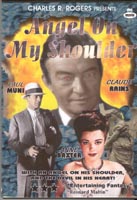

ANGEL ON MY SHOULDER
1946
Paul Muni
Claude Rains
Anne Baxter
A peculiar “deal” film again. How so?
Social Issues
Films have often looked at social issues raising the paradox of people saying “It is only a movie” (Don’t believe it) and “We should believe movies”. Consider “War of the Worlds” panicking America.
A number of socially responsible films (social criticism) have occurred over the years. Paul Muni was in, for example I Was a Fugitive from a Chain Gang which leveled accusations of brutality against the Southern chain gang system and brought about change.
Paul Muni himself was an remarkable actor who had been involved in a number of biopics about people who were socially significant:
Learned vs. innate as regards the nature of crime.
Where does the criminal element come from? Is it society-caused or from a failure in the person’s will power (like alcoholism).
Social determinism vs. free will.
There is a strong tendency to put everything bad about people into the socially caused area except “greed” and a few others. Capitalism is at fault, but capitalist are evil people they are not socially determined. Peculiarity is that if the speaker suffers from something it is societal – if not is it nastiness.
Same problem historically. Countries motivated by some historical force, but US not. A kind of peculiar racism here. Only certain people and countries are able to surmount socially and historical causation.
What is Hell like in this film. We have begun to look at the depiction of Hell in a few films: I’Inferno, Crazy as Hell
After The Film
Watch framing: in car Film has all the elements of entrapment like noir.
OUTSIDE OF HELL
Puns: What in my domain is that? (What in hell is that)
Reaction to religious personnel.
Devil is on the wrong side (against him).
Kids – innocents. They begin transformation after talk
Woman also some salvation. She is not Rosie!
Is the criminal element from social problems of listening to the Devil whispering in your ear?